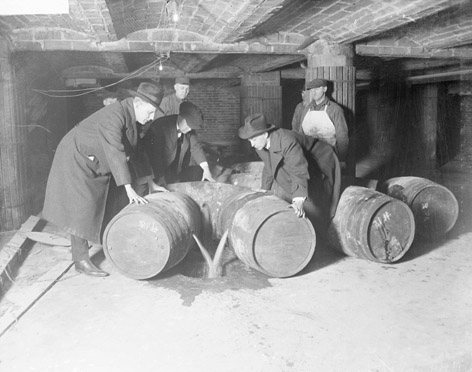Prohibition and Law
By the beginning of the 20th century, a growing number of Americans became convinced that excessive liquor drinking was to blame for many of society's problems, including poverty, alcoholism and violence, especially among families. While the Temperance movement initially believed that the main culprit was spirits with their high alcoholic content which made those who imbibed drunk more quickly, its supporters gradually became convinced that all alcoholic drinks were to blame, including beer and hard cider. This led to a change in message from Temperance, or a moderate approach to drinking, to Prohibition, or making all intoxicating drinks entirely forbidden.
When it became clear that American drinkers would not give up their alcohol willingly, Prohibition supporters saw no option but to make these beverages entirely illegal. What began as town and community bans and the shuttering of taverns and saloons on the local level soon made its way to the national stage.
World War I and Temporary Prohibition
With the United States' entrance into World War I in early 1917, it soon became clear that as many resources as possible needed to be put toward the war effort. In an attempt to divert US grain from being made into liquor, which was not seen as necessary, and to be put toward much more useful food such as bread, Congress passed the Wartime Prohibition Act in, banning the sale of beverages with an alcoholic content higher than 1.28%. However, this act went into effect in June of 1919, more than six months after the Armistice Agreement was signed, effectively ending the war.
With prohibition temporarily the law of the land, activists got to work to keep the ball rolling and enshrine prohibition into permanent law.
The 18th Amendment
Initially vetoed by President Woodrow Wilson, Congress overrode his veto, and The Eighteenth Amendment to the United States Constitution was ratified on January 16, 1919. When it went into effect on January 1st, 1920, it made the production, transport, and sale of intoxicating liquors illegal, although drinking alcohol was still legal. However, in spite of the sizable temperance movment, the extent of drinking across the United States and the significant number of bars, taverns, wineries, breweries, and distilleries, soon overwhelmed the police's ability to enforce the law.
To read the original document, follow this link to view it courtesy of the Library of Congress.
The Volstead Act
The National Prohibition Act, also called the Volstead Act after then-House Judiciary Committee chairman Andrew Volstead, executed the 18th Amendment to the United States Constitution which banned the sale of all alcoholic drinks. This means that it provided aid to legal systems to enable them to enforce the 18th Amendment
It also drove the allowable alcohol content in beverages down to just 0.5%. While this is intended to eliminate all intoxicating liquids, it should be noted that even your glass of morning orange juice may contain up to 0.8% alcohol by volume!
The Volstead Act also made strict guidelines for punishments of violations, including jail time and fines, and laid out rules for who could enforce the Act, and how they were permitted to do so.
To have a look at the original copy of the Act, follow this link to view it courtesy of the National Archives.

